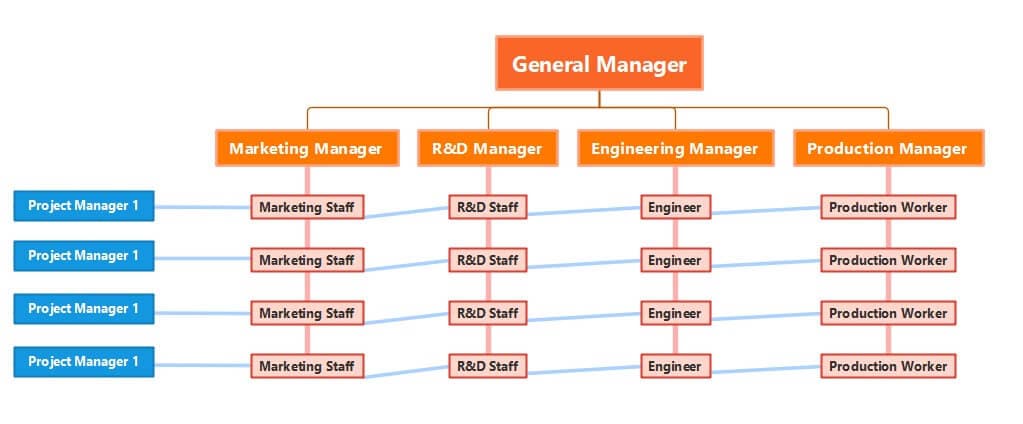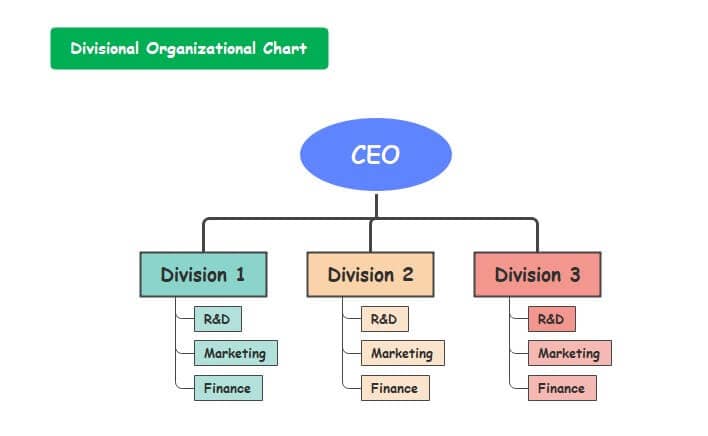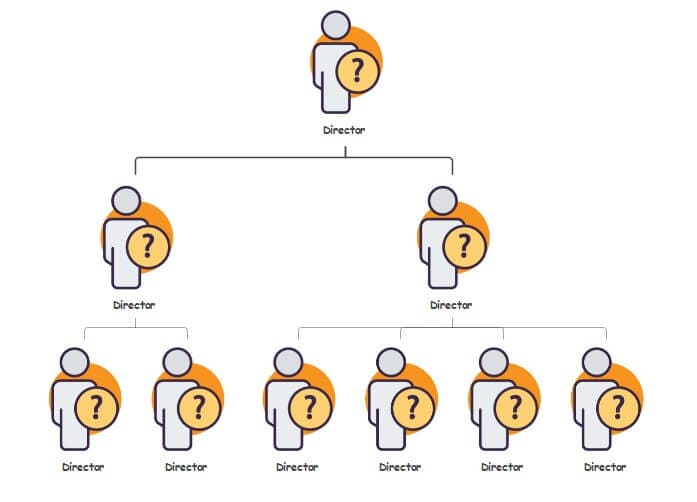You must have looked at an organizational chart at some point. These charts are significant for hiring an employee, onboarding one, or giving investors an outlook of your company. The most popular types of organizational structures come in a pyramid shape with a top-down hierarchy.
However, not every company has a high-to-low reporting line. Hence, different forms of organizational structure exist. Large enterprises prefer functional structures, whereas startups are comfortable with flat ones. The right structure depiction can improve productivity, transparency, and planning within a company.
This article delves deeper into understanding the seven common organizational structure types.
In this article
What is an Org Chart
An organizational or org chart is a visual depiction of a company’s internal structure. It showcases departments, roles, responsibilities, and associations between the workforce in a single organization. An average org chart builds employee profiles using boxes, shapes, illustrations, and photos. Similarly, straight and elbowed arrows make connections between these employees.
History of Org Charts
The first org chart was developed in 1855 by a railway general superintendent, Daniel McCallum. He illustrated a diagram of the Erie Railway and New York along with George Holt Henshaw. Fifty years later, consulting engineer Willard C. Brinton coined the term “organizational chart.”
In 1914, textbooks incorporated org charts as a graphic method to present facts. From here, the charts became popular in the engineering field. Today, they are widely used to represent government structures, bureaucracy, MNCs, national companies, etc.
How Are Organizational Charts Used?
Depending on the organization, these charts have diverse purposes. Here are a few of them:
- Showcase the reporting relationships.
- Help leadership manage the workforce and make effective decisions.
- Allows onboarding employees to understand the organization’s structure and ethics.
- Improve the line of communication in the complex hierarchical structure.
- Facilitate investors and stakeholders on how the company operates.
Benefits of Organizational Charts
Now, let us look at the advantages of the organizational charts.
Clear Reporting Structures
With a well-designed organizational structure, onboarding employees can learn the reporting structure and lines of authority. It is significantly important to navigate across departments. So they will understand right away who to contact.
Motivates Employees
A well-curated org chart is your roadmap to trace promotional opportunities. For instance, a marketing assistant can locate the advanced positions (marketing manager, social media marketer, digital marketing supervisor, and marketing manager) using the org charts. This way, they can use the right opportunities to excel quickly.
Helps Managing Workload
Organizational charts have easily accessible project information. Thus, at first sight, managers can visualize tasks and assess how many individuals are required for a project. Hence, locating the right people for the job is easy.
Makes Planning Easier
People in the middle and top of the hierarchy can plan for a project beforehand with an org chart. It allows them to allocate resources, find bottlenecks, employ the right people, and make decisions.
7 Types of Organizational Charts
Want to know what different forms of organizational structure convey and operate? Here are the seven most common organizational charts explained.
1. Hierarchical Organizational Chart
A hierarchical org chart follows the chain-of-command layout, from officials at the top to general management extending in a pyramid shape. Think of it like a kingdom or a company. The monarch or the CEO is on the top with absolute power. Within the hierarchy, members typically have one supervisor whom they report to.
Grouping members within a hierarchical structure depends on function, geography, and product. For instance, some companies group their employees according to technical, admin, etc functions or from what US states they come from.
Benefits
- A clear line of authority
- Better communication with the reporting officials
- Reduce employees’ conflicts and promote camaraderie
- Streamlines the business processes
Drawbacks
- Slows down the decision-making process
- Departmental focus instead of the company’s interest
- Less ownership by the low-level employees
2. Functional Organizational Chart
Functional org charts are a variation of hierarchy charts. Thus, it follows a top-down structure with reporting authority at the top, middle managers, etc. Typically, the employees are divided on their skill set and position in the structure.
Each department has its branch, administered separately. This way, the teams are self-sufficient, and employees focus on their roles. Usually, dominant organizations like governments, Multinational Corporations, and organized religious groups use functional authority lines.
Benefits
- Functional charts are easily scalable
- Each department is self-determined
- Encourages specialization and faster delivery time
- Better intra-department communication and clear line of authority
Drawbacks
- Lack of connection between the lowest and highest management
- No inter-departmental communication
3. Matrix Organizational Chart
Matrix org charts have a grid-like structure with several managers. But what’s the point? The matrix charts show cross-functional teams with the division of employees by project rather than hierarchy. Each chart has people with similar skills for a certain project. Hence, the employees report to the project manager and their functional department manager.
Let us understand this. A project manager onboards an engineer or a graphic designer for a project. They would otherwise regularly work under the technical or designing department's lead managers.
Benefits
- Boasts the project processes and delivery
- Employees gain experience in various capacities
- Project managers have the freedom to choose a better candidate
- Dynamic view of the company
Drawbacks
- Prone to department manager/ functional manager conflicts
- Changes more often than other types of organizational structures
4. Divisional Organizational Chart
A divisional organizational chart comprises several independent divisions within a company. Each division has independent IT, marketing, sales, accountants teams, etc. For instance, a big car company has a self-sufficient division for their popular car models.
Typically, the divisional structure fits the large organizations best. It boasts the operational flow and decision-making processes and eliminates the need for formalities. Some giant companies like McDonald's use multi-divisional or M-form charts. In the M-form structure, the parent organization has daughter subsidiary companies, each using an independent system.
Benefits
- Faster developments and operational flow
- Independent decision-making processes
- Promotes democracy and customizable strategies
- Understand the individual market better
Drawbacks
- Lack of coordination between divisions and the leadership
- It may result in duplicate resources
5. Flat Organizational Chart
In a flat organizational chart, there are three divisions among employees. Unlike hierarchical structures, the flat structure incorporates one layer of middle managers. It helps cut down the workforce from the middle, so fewer employees can make effective decisions independently. However, it demands self-sufficient and well-trained people.
Small companies and startups use this organizational model, as it requires less supervision and active participant interaction. Moreover, the operations and initiatives are transparent among the workforce.
Benefits
- Additional responsibilities for managers
- Promote trust among employees
- Enhance teamwork due to a shorter chain of command
- Effective and faster decision-making process
Drawbacks
- Limited opportunities for employee growth
- Risk of power struggle
- Low sense of accountability in the lower layer of the system
6. Network Organizational Chart
Unlike other organizational structure types, network charts are decentralized and focus on flexibility. The essence of network structures is social networks, open communication, and efficient members. Thus, they go far beyond the company’s internal workforce and depict the external networks.
These charts outsource independent vendors, technicians, contractors, etc, to join their forces in delivering a product or service. Simply put, a network structure has full-time employees and freelancers, so each person can perform specialized tasks. This way, the company can adapt to the market competition and make changes accordingly.
Benefits
- Promotes healthy competition and collaboration
- Make companies adapt quickly to the market challenges
- Excellent at streamlining tasks
- Improves organizational agility and flexibility
Drawbacks
- The structures can be complex
- It may result in unhealthy competition
- Confidentiality is compromised
7. Team-Based Organizational Chart
It is a no-brainer that team-based organizational structures divide the workforce into teams. These structures are a great success for teams working toward a project or common goal. The team charts are less hierarchical and have a flexible superiority structure, as the purpose is problem-solving and teamwork.
Typically, teams that are global adopt this model. A few common examples include Google, Apple, Cisco, etc.
Benefits
- Foster communication between employees
- Information flows quickly and efficiently between the members, improving the team’s problem-solving abilities.
- Promotes democracy and freedom for employees to make decisions
- There is a higher flexibility in the team structure
- Easy to adapt to future challenges
- Provides experience across the team
Drawbacks
- Individual conflicts can negatively impact the team
- Lack of clear promotional paths for employees
- Underperforming employees can be a setback
Conclusion
Understanding different forms of organizational structures is significant to maintaining the workload and planning ahead of time. Well-tailored org charts help you visualize an entity's reporting structure, line of authority, and work schedule.
You can leverage the EdrawMind template gallery to explore and understand similar organizational structure examples. Once you know the differences between them, building one is a no-brainer. Skim a little, find the right fit for your company, and personalize. Give it a shot; you may find it handy in streamlining routine tasks.










